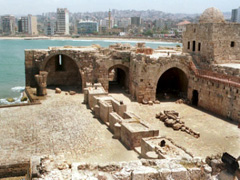

: GUIDE INFO :
- About Us
- Contact Us
- Social Media
- F.A.Q
- Plans
- Albums
- News & Events
- Get A Website
- Marketing Tips
- Useful Links
- International Links
: HOTELS DIRECTORY :
- Beirut Hotels
- Bekaa Hotels
- Mount Lebanon Hotels
- North Lebanon Hotels
- South Lebanon Hotels
: LEBANON INFO :
- Transportation In Lebanon
- Touristic Sites
- Featured Resorts
- Resorts>
- Grottos
- Embassies in Lebanon
- Photo Gallery
- Articles About Lebanon
- Songs About Lebanon
: SISTER SITES :
- AtLebanon Directory
- Advertise Lebanon
- Professional Innovations
- Lebanon Auto Guide
- Bcharre Chalet & Motel
: GOOGLE ADS :
|
» SIDON CITY LEBANON
 This city, 48km south of Beirut, has one of the most famous names in history but its past has been plundered by time and by invader. Sidon was inhabited as early as 4000 B.C. and today is home to a Crusader fortress that rises out of the sea, a Murex hill formed by the refuse of the purple factories of antiquity, and ancient Necropoli.
This city, 48km south of Beirut, has one of the most famous names in history but its past has been plundered by time and by invader. Sidon was inhabited as early as 4000 B.C. and today is home to a Crusader fortress that rises out of the sea, a Murex hill formed by the refuse of the purple factories of antiquity, and ancient Necropoli.
The entrance to Sidon from the north is on a wide divided highway lined with palm trees. As you approach, the landmark Crusader Sea Castle and modern port installations are immediately visible.
A government Resthouse on the waterfront next to the castle offers good food and refreshment. Situated in a restored medieval building, the Resthouse is set in a landscape seaside terrace. The interior has vaulted ceilings and medieval décor. Not far from here is the picturesque vaulted souk of Sidon, where workmen still ply their trades. On the edge of the souk is a traditional coffee house where clientele meet to smoke the arguileh (water pipe) and sip Turkish coffee. South of the souk on the way to the Castle of St.Louis, is the Great Mosque, formerly the Church of St. John of the Hospitalers. The four walls of this building date back to the 13th century.  The Castle of St Louis, or Qalaat Al-Muizz, was erected on the emplacement of a Fatimid fortress during the Crusade led by the French King Louis IX, popularly known as St Louis. Built in the mid-13th century, the present state of the castle makes it easy to observe various stages of the restoration carried out in the Mamluke era, particularly work done in the 17th century by Emir Fakhreddine II. At the foot of the hill are a dozen or so Roman columns scattered on the ground.
The Castle of St Louis, or Qalaat Al-Muizz, was erected on the emplacement of a Fatimid fortress during the Crusade led by the French King Louis IX, popularly known as St Louis. Built in the mid-13th century, the present state of the castle makes it easy to observe various stages of the restoration carried out in the Mamluke era, particularly work done in the 17th century by Emir Fakhreddine II. At the foot of the hill are a dozen or so Roman columns scattered on the ground.
|
|










 Lebanon Auto Guide
Post,Buy your car.
Lebanon Auto Guide
Post,Buy your car.
 Chalets & Loding Rooms
One of Besharry/Al-Arz Tourists Destination
Chalets & Loding Rooms
One of Besharry/Al-Arz Tourists Destination